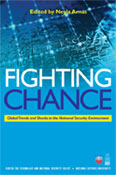 This chapter is from a paper prepared for a September 2007 conference. It appears in Fighting Chance: Global Trends and Shocks in the National Security Environment (October 2009) and is reproduced here with permission from Potomac Books, Inc.
This chapter is from a paper prepared for a September 2007 conference. It appears in Fighting Chance: Global Trends and Shocks in the National Security Environment (October 2009) and is reproduced here with permission from Potomac Books, Inc.
Introduction
Russia for the past 4 years has been on an economic roll fueled by high energy prices. The Kremlin in parallel has pursued an increasingly assertive foreign policy, raising the prospect of a more contentious Russia that will challenge U.S. interests in the former Soviet space, Europe, and elsewhere. The challenges posed by a more assertive Russia will command greater time and attention from U.S. national security planners.
It is not only a resurgent Russia that could test the United States in coming years, however. A frail, unstable Russian state is not in the U.S. interest. Russian weakness raises less obvious, but nevertheless serious, possible challenges. Demographic, societal, and economic trends within Russia have the potential, particularly in combination, to create strategic shocks over the next 10 to 30 years that would have major implications for U.S. national security interests. This chapter examines those trends and potential shocks and outlines implications for U.S. national security.
The strategic shocks that trends within Russia could combine to produce include collapse of the Russian state, expansion to take in more ethnic Russians, revolution (leading to a lurch toward democracy or, more likely, to the right), playing the energy card, and a military/technical surprise. While these shocks each have a very low likelihood, any of them would pose critical implications and challenges for key U.S. security interests. This chapter also looks at possible shocks elsewhere in the former Soviet space: Islamic revolution in a Central Asian state and Georgian-Russian military conflict, with the latter being the most likely shock of those addressed.
The Brookings Institution is committed to quality, independence, and impact.
We are supported by a diverse array of funders. In line with our values and policies, each Brookings publication represents the sole views of its author(s).


Commentary
Global Trends and Shocks in the National Security Environment: Russia and Eurasia
October 1, 2009